Beginners Guide To Winter Backpacking
Want to take your backpacking to the next level? Winter backpacking is a great way to test your backpacking skills. Backpacking in the winter is ten times more difficult than in the summer. But if you can pull it off, you can have some of the most magnificent views out there. This post talks all about how to start backpacking in the winter. It is filled with excellent tips and tricks to help you stay warm and comfortable during freezing temperatures. Enjoy!
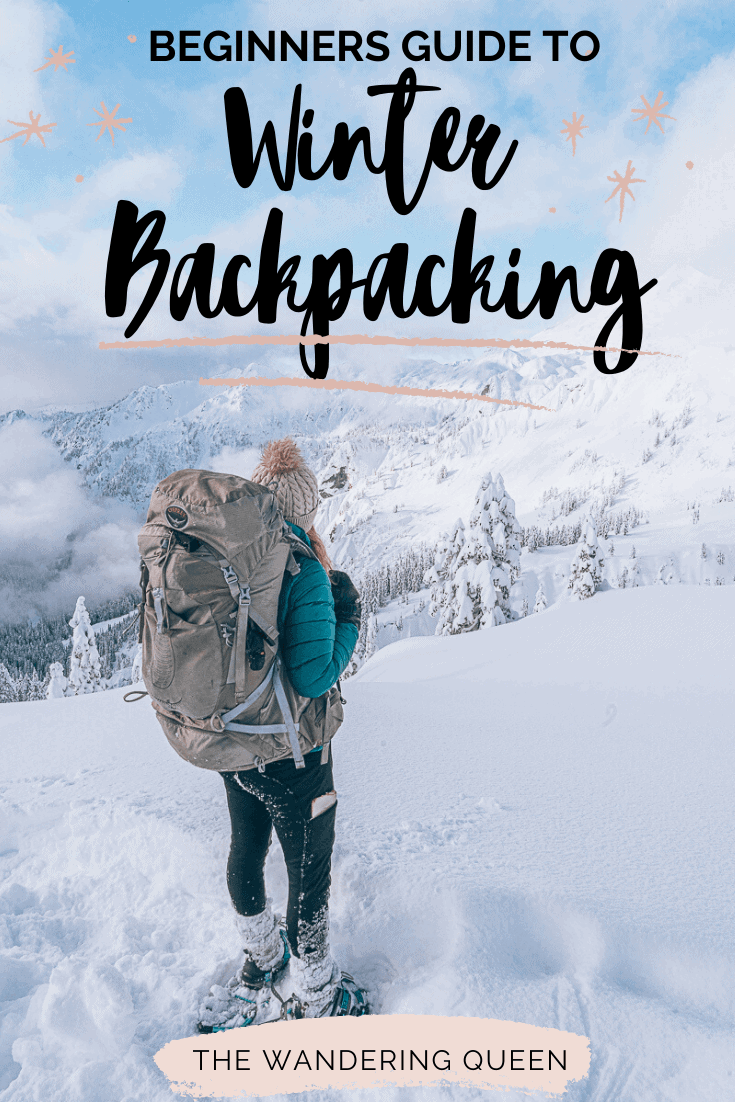
Disclosure: This post contains affiliate links. If you click one of them, I may receive a small commission (for which I am very grateful for) at no extra cost to you.
Download my free Outdoor Photography Guide
Winter Backpacking Tips
Planning Your Trip
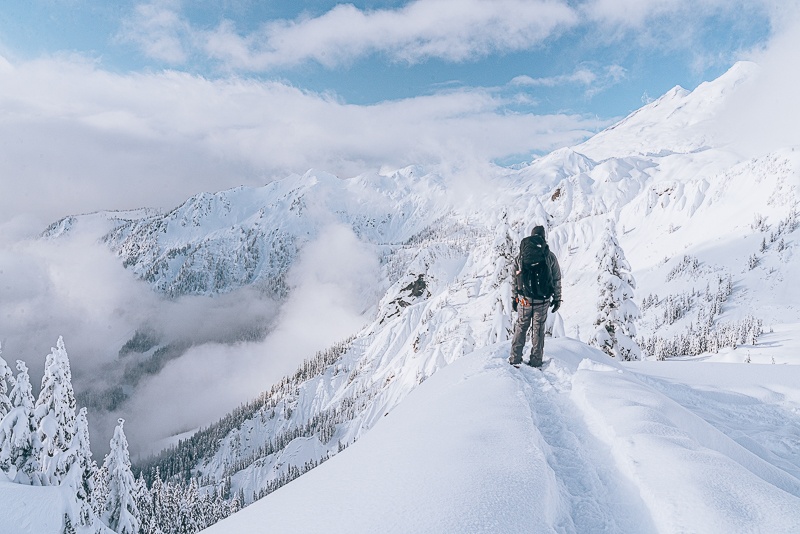
When it comes to planning your first backpacking winter trip, make sure you pick a short trail. Conditions might be miserable, and you might want a chance to get out of there quickly and easily.
Backpacking in the wintertime is a lot more complicated than the summertime. In the summer, you can easily see where the trail is. It the winter, it is entirely different. You pretty much have to either follow a path someone previously made up or make up your trail.
Making your trail is not as easy as it sounds. It is freaking hard. Add in some elevation gain, and you will be huffing and puffing. Also, if you are hiking while it is snowing, you might have terrible visibility. It can get a little scary not being able to see even just a few feet in front of you.
I highly recommend not just having a physical map and compass, but an app on your phone to navigate your way through the snow. When we went winter backpacking for the first time, we could barely see a few feet in front of us. Luckily we had the Alltrails Map Pro to navigate our way. Make sure to keep your phone nice and warm and close to your body. It might freeze. It has happened to me before! But once it is warm, it usually goes back to working normal.
Learn About Avalanches
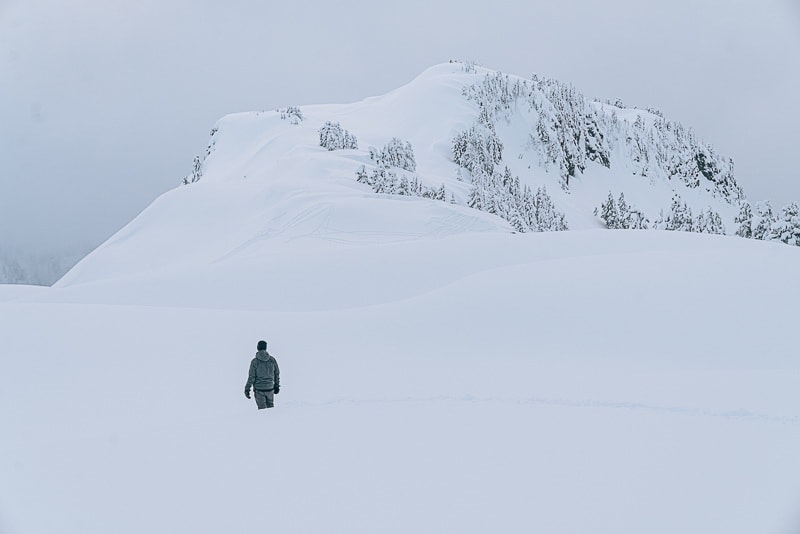
One of the most important things to do before going on your backpacking trip is to learn about avalanche safety. Any slopes over 40° can be considered an avalanche zone. It is best to take a course on safety beforehand. The best course to take is the AIRAE-1 course. REI sometimes has free beginner avalanche safety courses in certain areas. You can also keep an eye on avalanche areas using Avalanche.org. I am continually looking at this website on weekends for even just hiking; not just for backpacking.
Set Up Camp
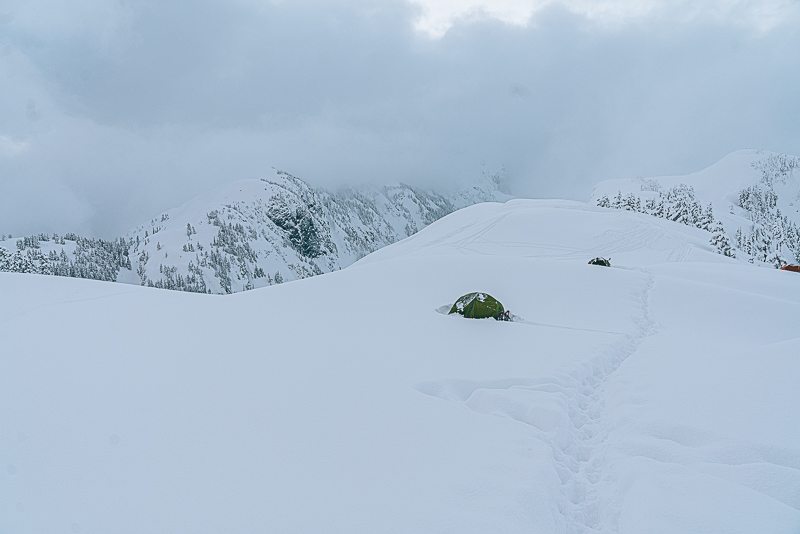
Winter Camping Hacks:
- When camping in snow, do not set up camp near any slopes, especially any over 30 degrees.
- Try to set up near water sources, like a river or creek.
- Watch out for old dead trees. If it is snowing heavily, they can fall on top of your tent. We have heard trees fall while winter camping. One of the scariest sounds to hear while you are sleeping.
- Choose a spot that is sheltered from the wind. Make a wind wall with the snow if you can’t find one.
- Don’t forget where your campsite is. It is easy to lose yourself in a snowy landscape.
- When snow camping, pack down the snow with your snowshoes before setting up camp.
- Use tent stakes designed for snow.
Tips To Staying Warm: Winter Camping 101
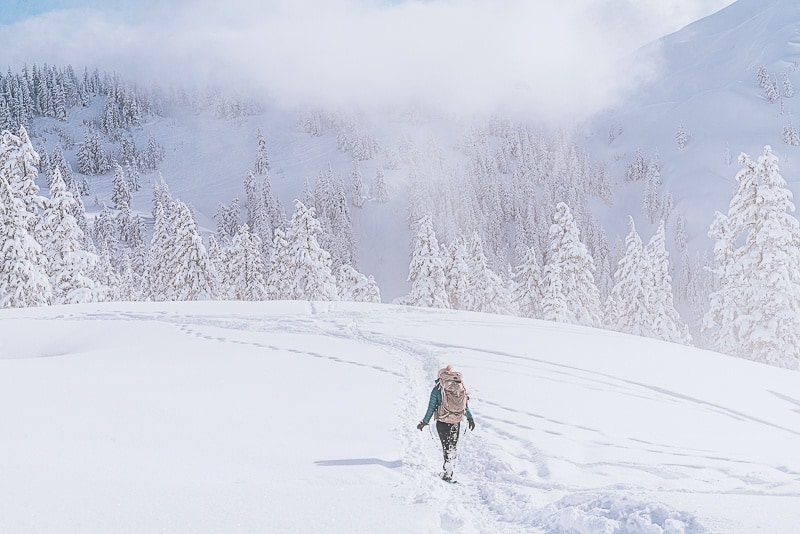
I am not going to lie, winter backpacking can be pretty miserable at times. It can be extremely cold! But the views and the beauty of some of the areas when you go winter backpacking makes it worth it! You just have to accept that you will be cold and uncomfortable at times. But I still want to give some tips for staying warm. Just to make it a bit less miserable for you.
- Bring some hand warmers. I sometimes like to use these on my toes. When it comes to winter backpacking, my toes are the first thing to get cold. >Buy Hand Warmers Here
- Exercise before getting into bed. Do some quick jumping jacks and then jump into your sleeping bag as it will keep in the heat you just created.
- Get a good sleeping pad with an excellent R-value so you won’t lose body heat. I talk more about this below.
- Eat a snack before you go to sleep. Your working digestive system, while sleeping, will keep you warm.
- If you need to pee, then pee. I know it sounds terrible to get out of your warm sleeping bag to the cold unknown outside, but your body diverts energy to keep your urine warm in your bladder, making the rest of your body colder.
- Melt snow and boil up some water and pour it in a Nalgene water bottle and put the bottle in your sleeping bag.
- Keep batteries with you when you sleep, like your phone, PLB, and camera batteries.
- Do not overlayer. The sleeping bag with not work if you do. I try to wear only base layers and thick wool socks. I will say that my feet are always the most difficult to keep warm, so I do add hand warmers or more socks to my feet.
- Remove your wet damp clothing. Bring a new fresh pair of base layers to go to sleep with. This includes socks. Do not wear the same socks you used on the hike.
Join my Newsletter to receive my free Backpacking Checklist!
Subscribe to have posts delivered straight to your inbox!! PLUS, get my FREE backpacking checklist!
What To Wear For Cold Weather Camping
Base Layers
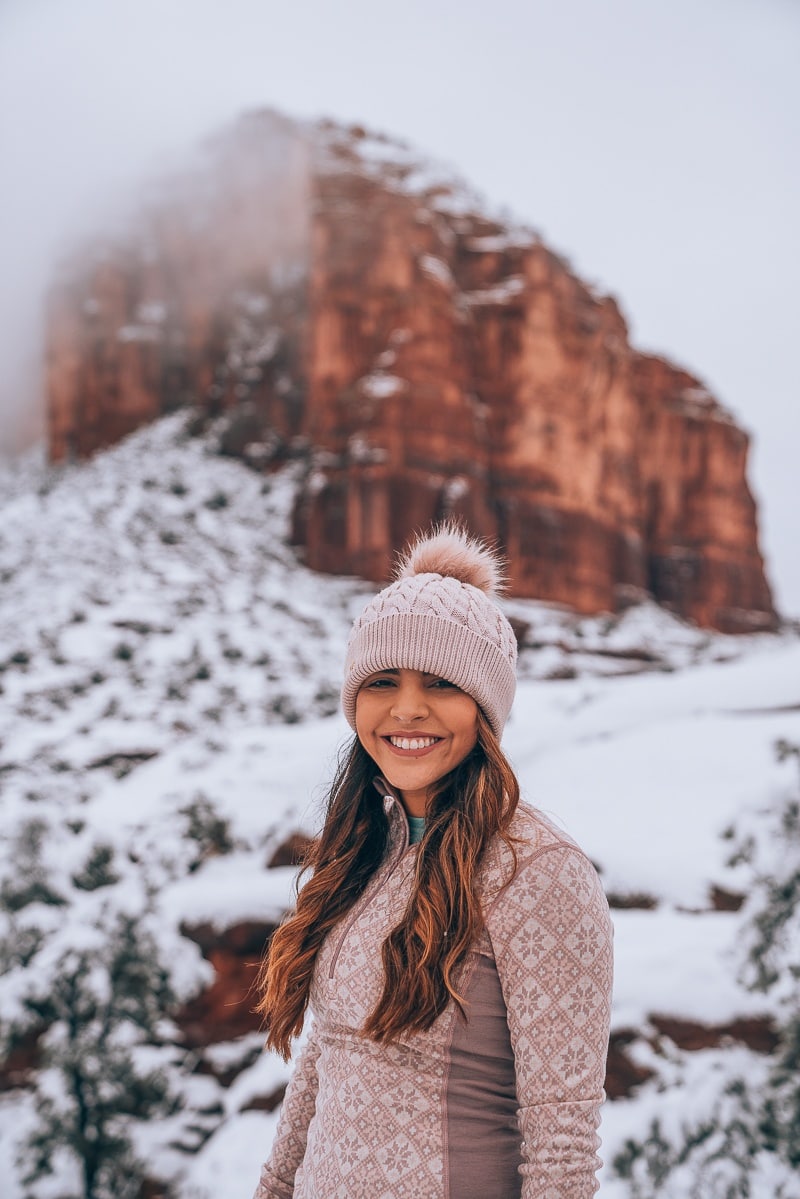
Base layers are the bottom layer of your winter gear. I recommend getting a few of these and layering them on top of one another. In the picture above, I am wearing two Base Layers. The pink ones are my Kari Traa Base Layers, and the one on the bottom is my Smartwool base layers.
I also recommend getting some bottom base layers. I love my Smartwool Base Layers Located Here. On top of these layers, I usually wear my Northface leggings, which I talk about below.
Fleece Jacket
A fleece jacket is perfect for a mid-layer. I don’t use the mid-layer while I am hiking or moving around because then I get too hot. So I usually wear this when I am sitting around or eating. Patagonia has some of the best Fleece Layers. >Buy A Patagonia Fleece Layer Here
Down Jacket
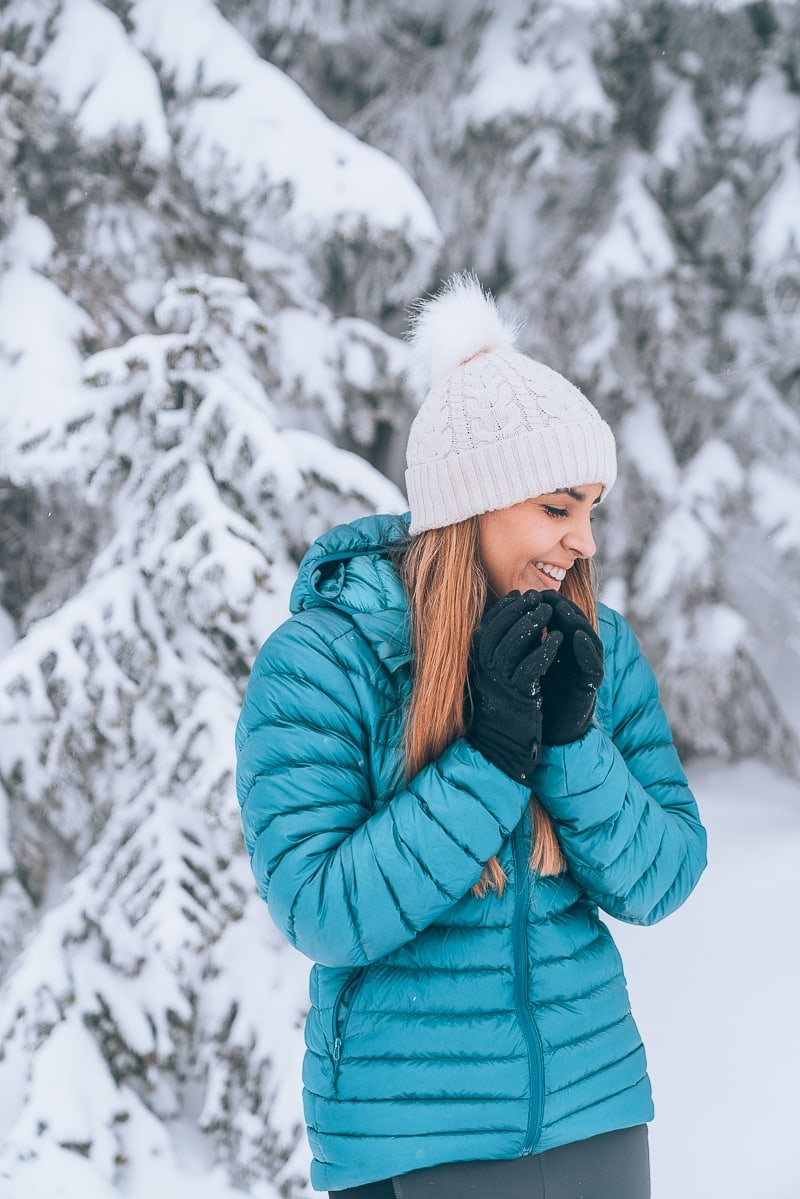
A nice warm down jacket is one of the most important things to wear while winter backpacking. This jacket should keep you warm but at the same time be breathable enough not to feel stuffy when you are hiking. > Check Out My New Favorite Blue Hiking Jacket
Gloves
The last time I went winter backpacking, every time I took off my gloves, my fingers hurt! That is how cold it was. So make sure to bring gloves! >Check Some Out Here
Sunglasses
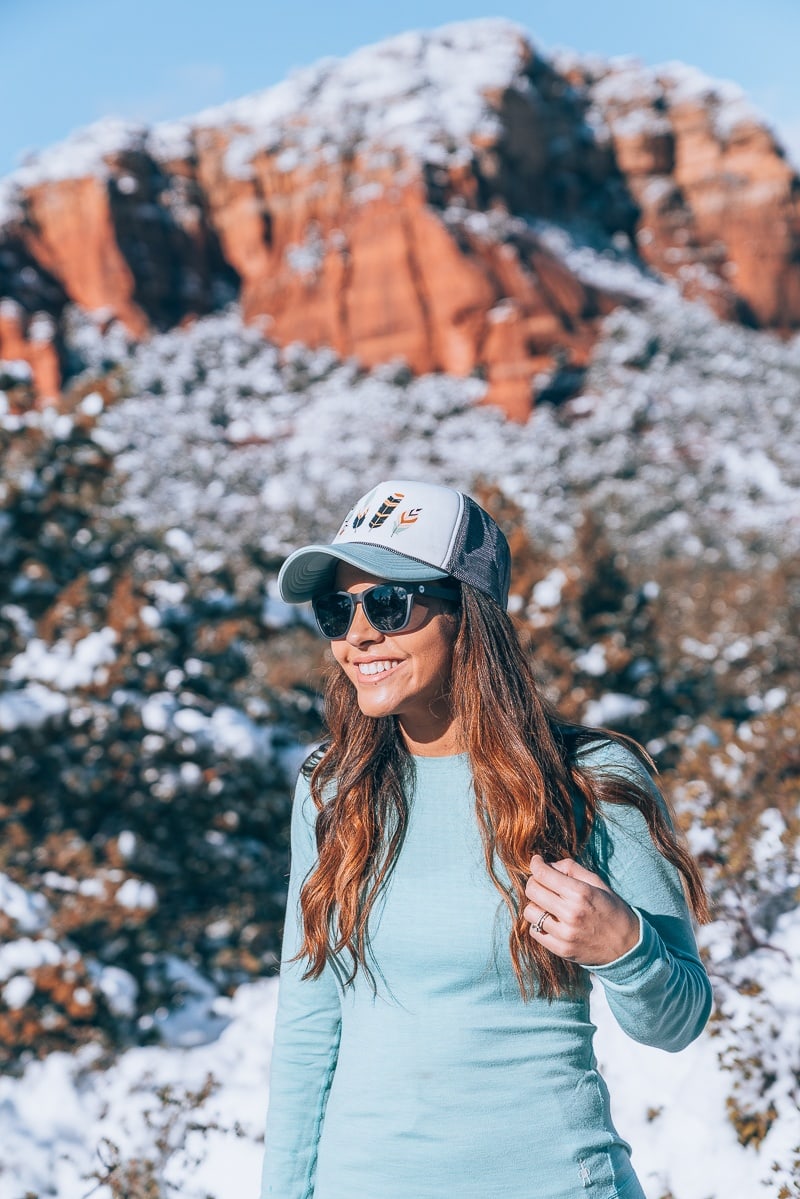
With the sun reflecting off the snow, it is crucial to have sunglasses. It makes it easier to walk around without feeling disoriented with so much bright white snow. >Buy My Adventure Sunglasses Here
Leggings
As many of y’all know, I am not the biggest fan of hiking pants. Not even in the wintertime. The reason is that I found the most comfortable and warm winter insulated leggings! They are amazing, even in the snow. >Check Out My Favorite North Face Leggings Here
Hiking Shell Pants
I still am not a fan of hiking pants, but I sometimes wear them when the weather is way too hardcore. I usually wear a couple of base layers below these pants. >Check Them Out Here
Buff
On extra windy days, buffs are a great accessory to have. They prevent your face from freezing. I love my Smartwool one. >Check Out My Cute One Here
Hat
You lose most of your body heat through the top of your head. That is why I always have a hat on in almost all of my winter pictures. >Buy A Warm Hat Here
Winter Hiking Boots
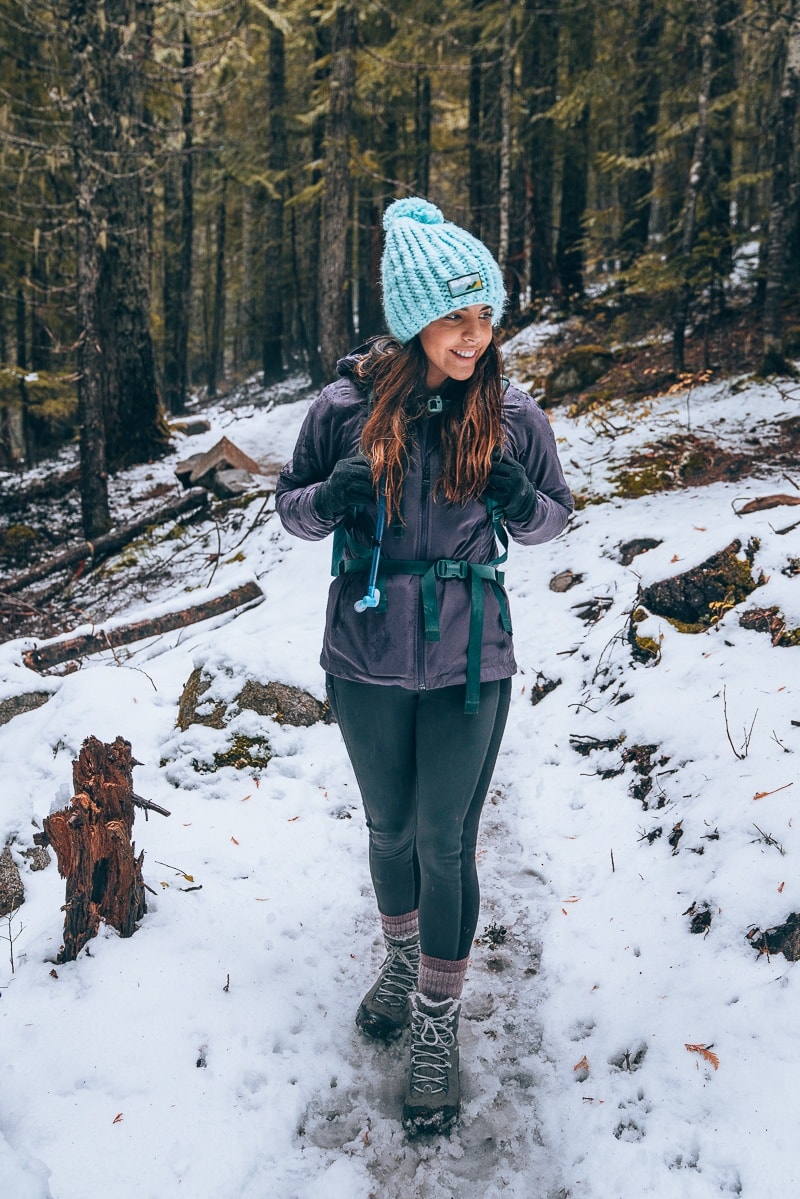
When it comes to camping or backpacking in the snow, one of the first things that will get cold are your toes! We have experienced this so many times over the years! I used to hike with regular hiking shoes or hiking boots in the snow, but I have since upgraded to insulated hiking boots. They feel a million times better! The traction works better with snow, and they are incredibly warm! Please note that you still need to get warm socks as well. >Check Out My Cute Winter Boots Here
Want To Learn More About Winter Boots?: Read About The Best Winter Boots In The Market Here
Gaiters
Gaiters help with preventing snow from getting into your shoes. I don’t always wear them because I don’t have that problem that much, but they are a great item to have just in case. >Check Them Out Here
Wool Socks
I recommend bringing wool socks on your backpacking trip to the extreme! Do not skimp out on this. Your toes will be the first thing that will get cold. Bring some extra warm wool socks.
Also don’t just bring one pair of socks, bring many warm socks. I promise you; you will thank me later. When you hike, your socks will get wet because of your sweat. When you sleep, you cannot wear those same socks. Your sweaty socks will eventually freeze due to the temperature, and you will pretty much be wearing icy socks. Your feet will be freezing. Trust me, it is not fun to sleep with frozen socks. >Buy Many Warm Socks Here
Outer Shell
There are times when it snows/rains on me while hiking or camping in the snow. In some areas, there are chances of it raining even if you are surrounded by snow (It has happened to me before). It is not fun to be soaking wet in the wintertime, so I recommend getting a rain jacket or even a poncho just in case. >Check Mine Out Here
Crampons/Microspikes
Crampons or Microspikes are great for icy, slippery conditions. I have hiked on many trails where the rock was frozen over with ice. These are perfect conditions for using your microspikes. >Check Out These Microspikes Here
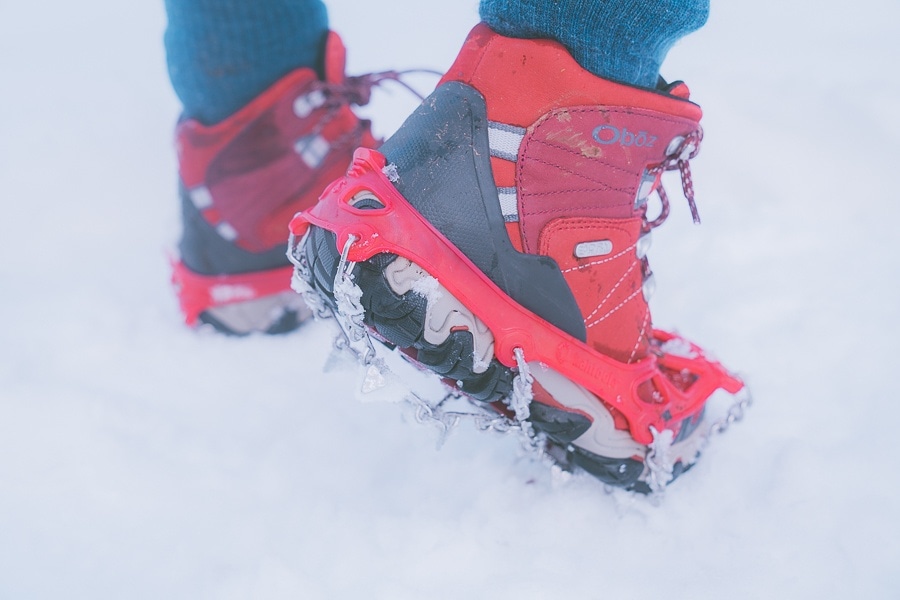
Snowshoes
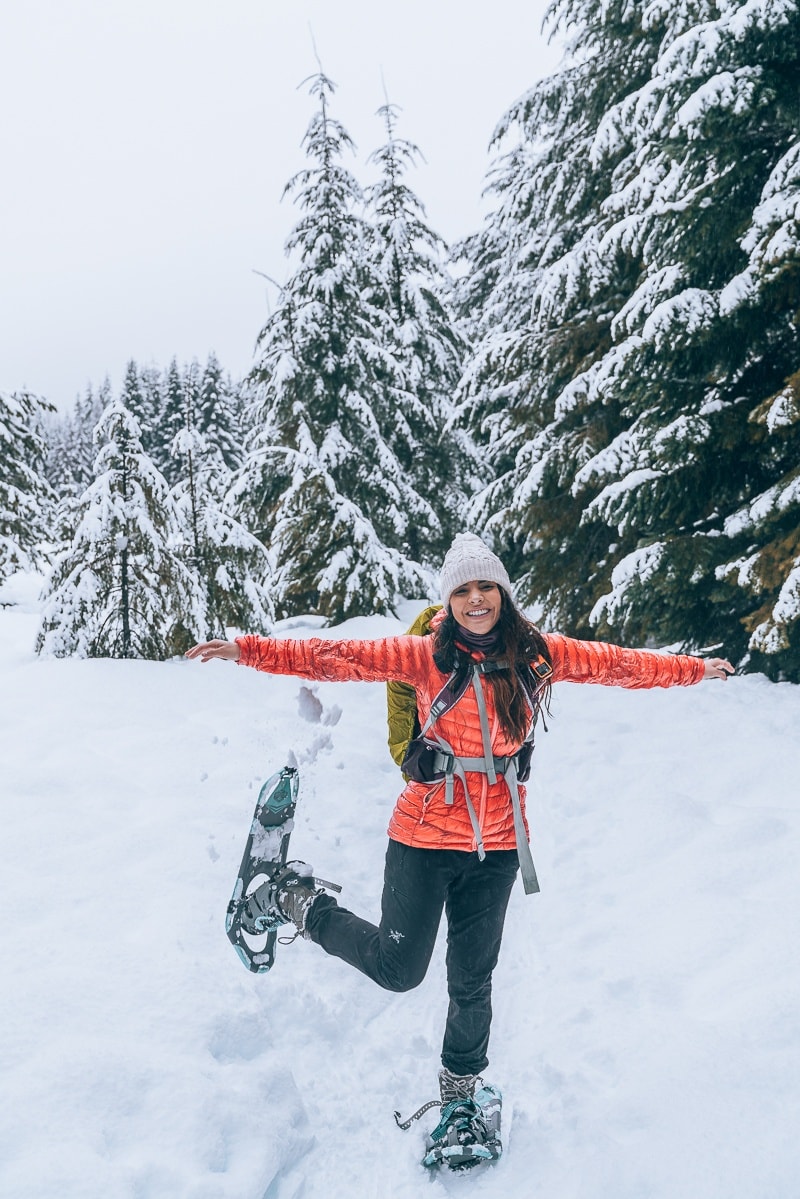
Snowshoes are a pretty expensive item to buy but, in some situations, you need them. When there are over 5 feet of snow you need to trek over, they help prevent you from sinking into the snow. Especially if you are wearing a heavy backpack. Crampons will not help you here. >Buy My Super Cute Snowshoes Here
Trekking Poles
Trekking poles help with balance. There is something about snow that always makes me slip and fall many times! Luckily I have trekking poles. >Buy My Trekking Poles Here
Learn All About Trekking Poles: 10 Best Trekking Pole In The Industry
Ultralight Winter Backpacking Gear List
Backpack
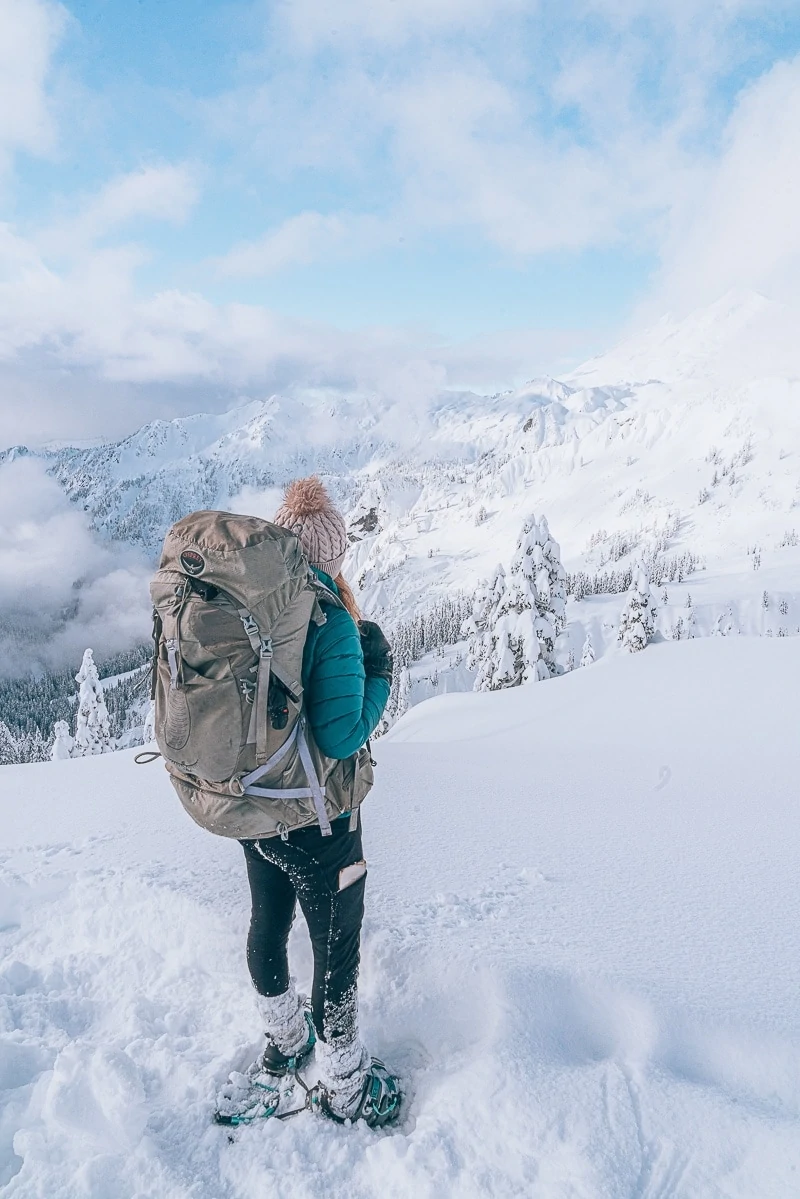
When it comes to backpacking, having the perfect pack that fits your body and gives you support is extremely important. I have bought an extremely cheap backpacking backpack once, and it ruined my back for weeks! I threw it away only after using it once and upgraded to an Osprey backpack. You can’t go wrong with an Osprey backpack. They are known to have the best packs in the hiking and backpacking industry. >Check Out My Osprey Backpack Here
Want to learn more about women’s backpacks? Read: 10 Best Backpacking Backpacks On The Market
Winter Tent
A light, compact tent is crucial for backpacking any time of the year. But in the wintertime, the weather can get extreme, so you might want to think about backpacking with a winter backpacking tent. Four season tents are known to be heavier and not as compact as a three-season tent, but they protect better against winds and temperatures. >Check Out This Tent Here
I do want to say that it is possible to camp with a 3 season tent. I have done it recently, and we were fine. I know spending money on two tents can be stressful, so don’t stress out and use your 3 season tent. Just make sure the wind isn’t insane, and I wouldn’t recommend it after two or three days. >Check Out My Tent Here
Want to learn more about Backpacking Tents? Read: 10 Best Backpacking Tents
0° F Sleeping Bags
I highly recommend bringing at least a 0° F sleeping bag on your winter expedition. Usually, the rating that the manufacturers provide is the minimum temperature the sleeping bag is rated for preventing hypothermia. It does not mean you will be comfortable, though. If you are sleeping in 20 degree-30 degree weather, then a 0-degree sleeping bag will provide you more comfort. >Check Out My Sleeping Bag Here
Sleeping Pads
In the wintertime, sleeping pads are essential. Do not go backpacking in cold temperatures without one. You will be incredibly uncomfortable, and it will feel like you are sleeping on a block of ice. I have experienced this, and it is not fun!
Sleeping pads help insulate you and keep you warm at night. With a combination of a suitable sleeping bag and sleeping pad, you can sleep comfortably through the night without worrying about being cold.
The thing to look for in a winter sleeping pad is the R-value. The R-value measures how much a sleeping pad can Resist the heat flow. The higher the R, the warmer the sleeping pad. Since women tend to be campers who sleep cold, it is essential to buy a sleeping pad with an excellent R-value (Like a 4 and above). Luckily I have the perfect sleeping pad to use in the wintertime. >Check Out The Best Sleeping Pad Here
Some people also add a foam pad under their air pad for extra insulation. >Check Out This Foam Pad Here
Read More On Sleeping Pads: 10 Best Sleeping Pads In The Market
Pillows
Pillows are not essential, but it is nice to have when you are falling asleep. I have had the Exped for years and love how compact they are. >Check Out My Pillow Here
Canister Stoves
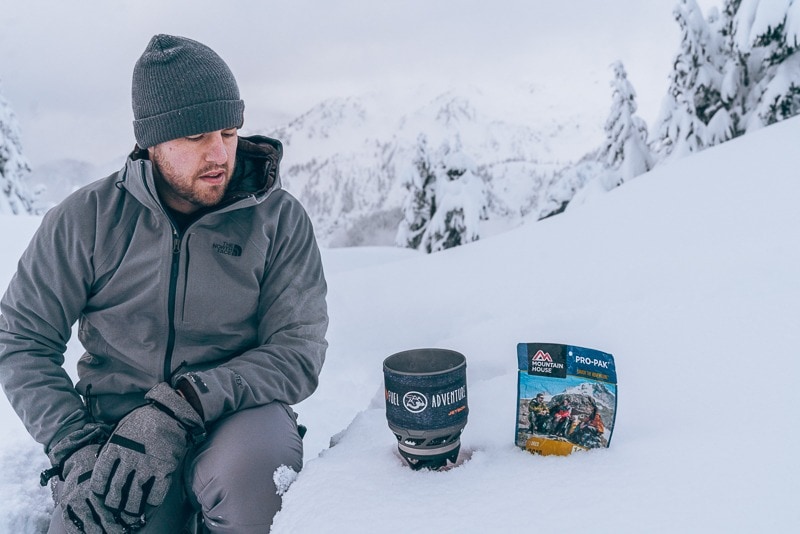
When it comes to backpacking in the summer, there are times that I don’t bring stoves with me. Why? Because they are bulky and heavy, and if I am backpacking only for a day, why cook anything when I can just eat packaged foods like tuna.
But I do not recommend this thinking in the wintertime. Even if you are not cooking, always bring a stove. If you run out of water, you will have to melt the snow to add it to your water bottle. Please note that liquid fuel is best for temperatures below 20-degree Fahrenheit. >Check Out The Stove Here
Food
When it comes to backpacking, I usually buy dry food to eat. What I do is boil water on the jet boil and pour it over the dry food. You can make your recipes using a dehydrator, or you can be lazy like me and buy some at REI. >Buy Dry Food Here
Snacks
Snacks are a great thing to have while you are trekking through some heavy snow. I always keep them on my belt pocket for easy access while I’m hiking. >Check Out Some Snacks Here
Map and Compass
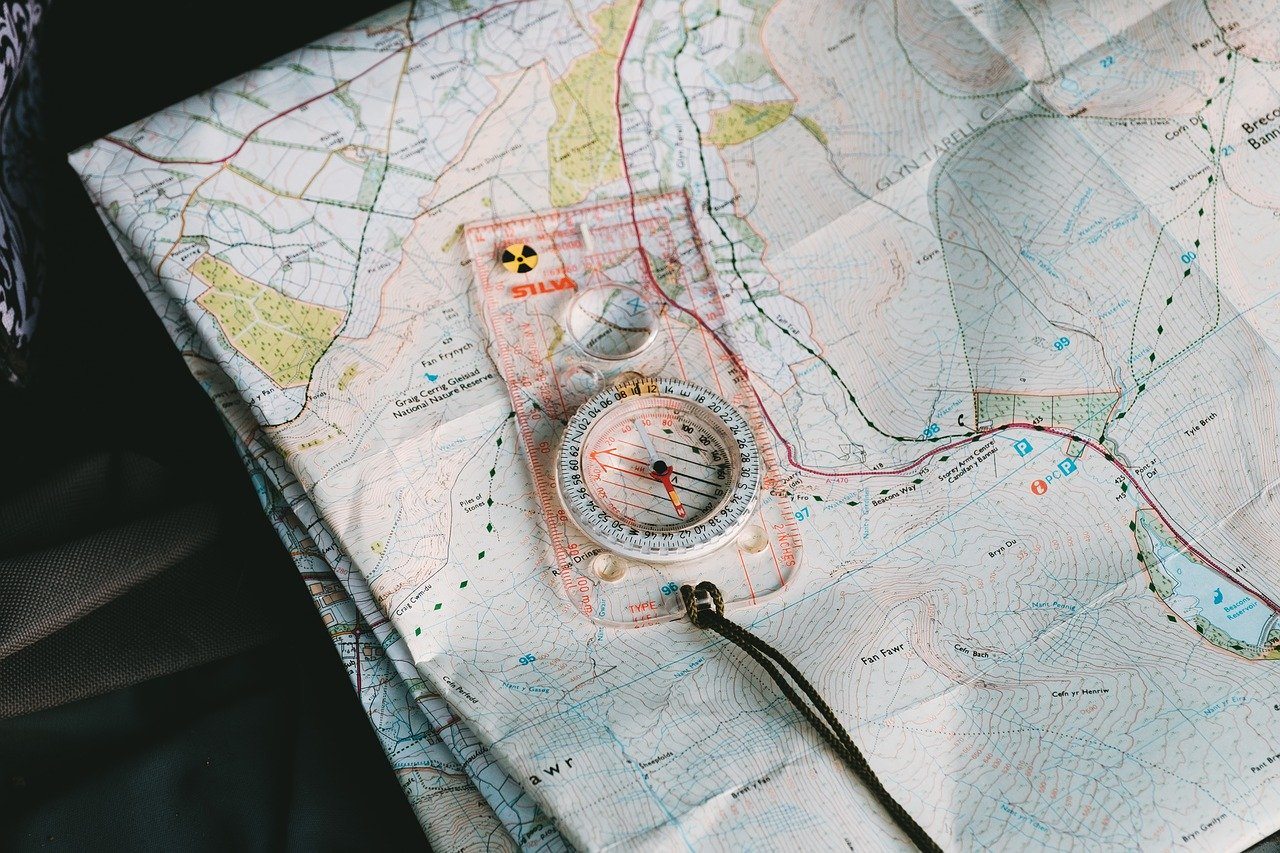
Never leave without a physical map and compass. When we were backpacking through the North Cascades, there was a point where we could barely see a few feet in front of us. It was snowing so much. I was using the All Trails map to direct us, but what if my phone had died? Or what if it had frozen (Which has happened to me while I was hiking on a different trail). What would we have done to navigate ourselves out of there? We would have used our map and compass. I am so glad we had it, and that is why we were not panicking. We had more than three ways to navigate ourselves out of there. >Check Out The Compass Here
Sun Protection
Even in the winter, you can definitely get sunburnt. Especially with the snow reflection. >Buy Some Sun Protection Here
First Aid Kit
Always bring a first aid kit with you on all adventures. I like to bring the extended version on my backpacking trips. >Check Out This First Aid Kit Here
Fire Starter
Even if you are not going to start a fire on your backpacking trip, it is highly recommended to bring a fire starter in case of an emergency. This is already the case while backpacking in the summer and is increased tenfold while backpacking in the winter. >Check Out My Fire Starter Here
Hiking Tools
I always bring a knife with me everywhere in case of an emergency and sometimes duct tape. >Buy A Knife Here
Water Bottles
I know water reservoirs are usually the best way to stay hydrated, but the thing is, the hose can freeze when you are backpacking, making the contraption useless. A water bottle is the best way to go. I recommend one that is not affected by the temperatures outside like a Hydroflask. They are heavier, but there is nothing more annoying than having frozen water while you are dying of thirst. >Check Out My Hydroflask Here
Head Lamp
One of the ten essentials the headlamp is definitely needed on your adventures. You never know if a trail will take longer, then you thought. Also, as I said earlier, your phone might freeze on the trail (It has happened to me before), so relying on your phone is not a good option for lighting. >Check Out My Headlamp Here
Personal Locator Beacon
One of the best ways to keep safe is to bring a personal locator beacon. 80% of the time I am hiking I don’t have service. So having a nice satellite while hiking in the winter makes me feel a lot safer. On my last trip, I sent preset messages to my mother in law when we were in our tent safe and sound. You can also send SOS signals to emergency services, and they can find your location.
I will warn you that these devices are expensive, and you have to pay for a monthly fee, but feeling safe on these cold expeditions is worth it to me. >Stay Safe And Buy One Here
Final Thoughts On Camping In Winter
Thank you for reading all about winter backpacking! I hope you stay nice and warm on your next adventure 🙂 Make sure to check out some of my other outdoor blog posts:
- Hiking In The Winter Gear
- Best Hiking Winter Shoes
- Best Backpacking Gear In The Summer
- What To Wear Snowshoeing
Join my Newsletter to receive my free Backpacking Checklist!
Subscribe to have posts delivered straight to your inbox!! PLUS, get my FREE backpacking checklist!
Pin For Later: Camping In The Winter
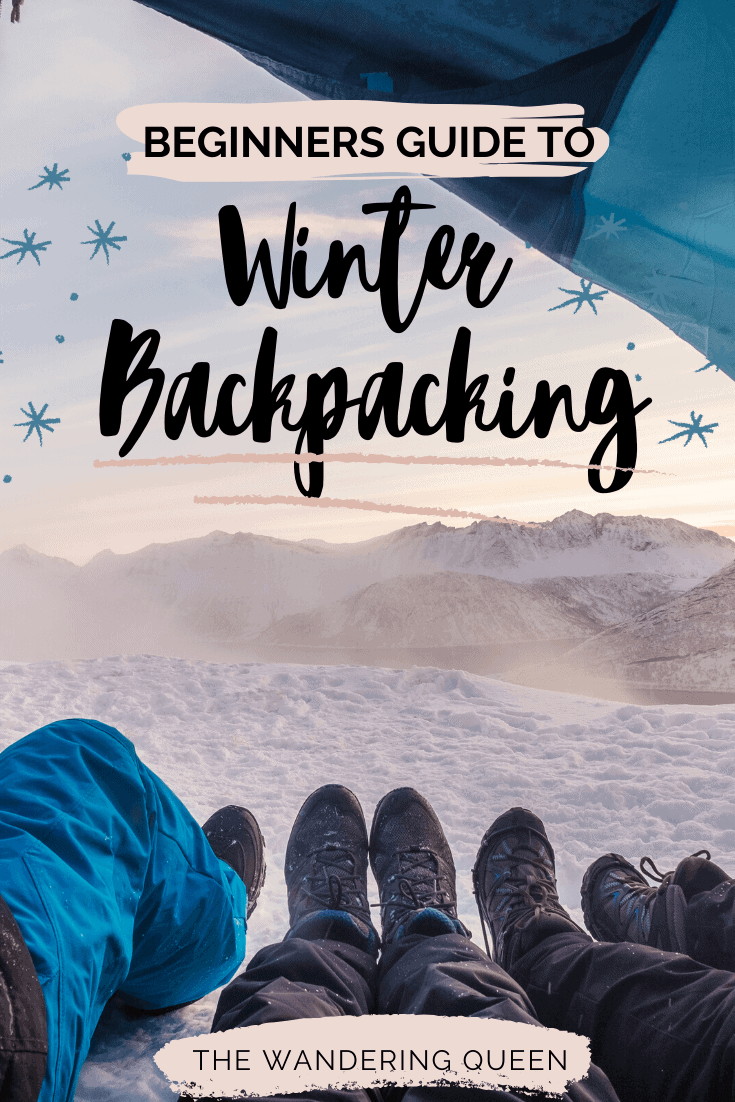



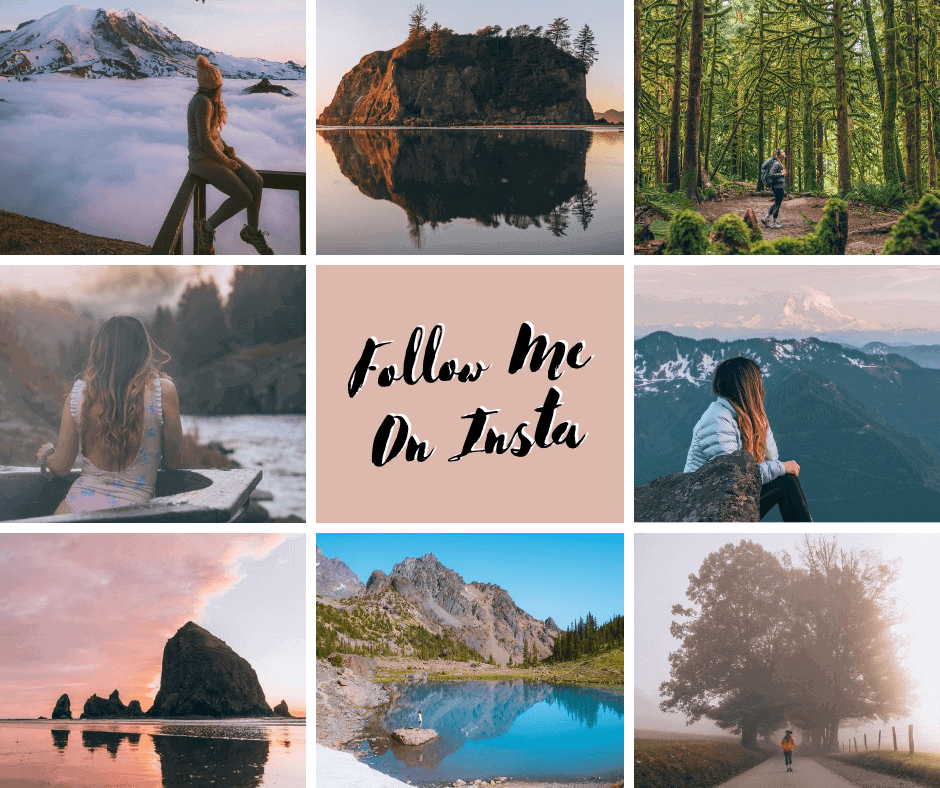
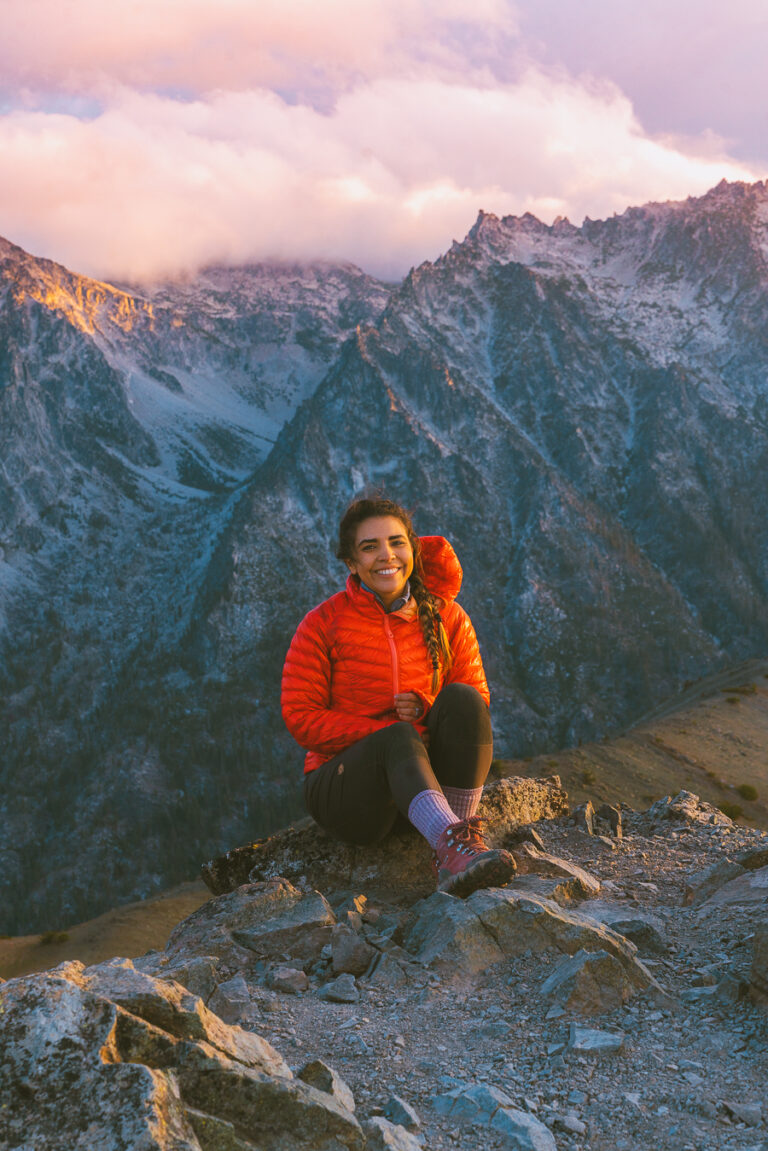
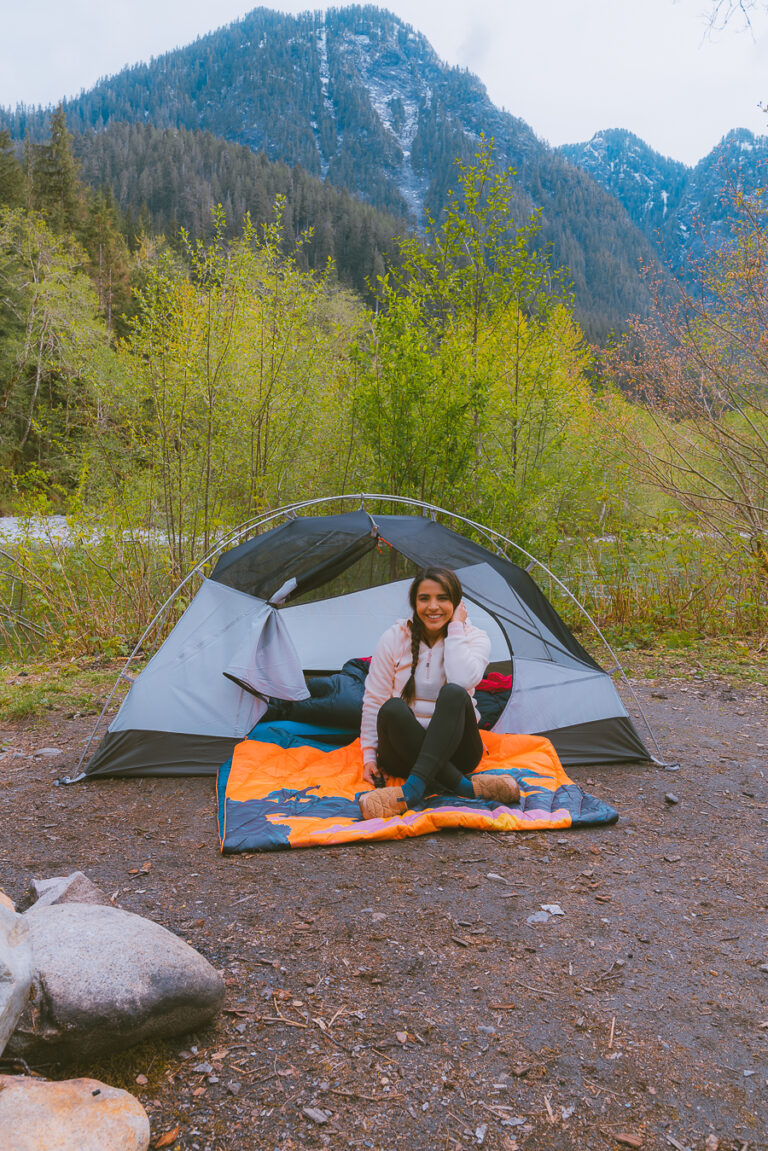
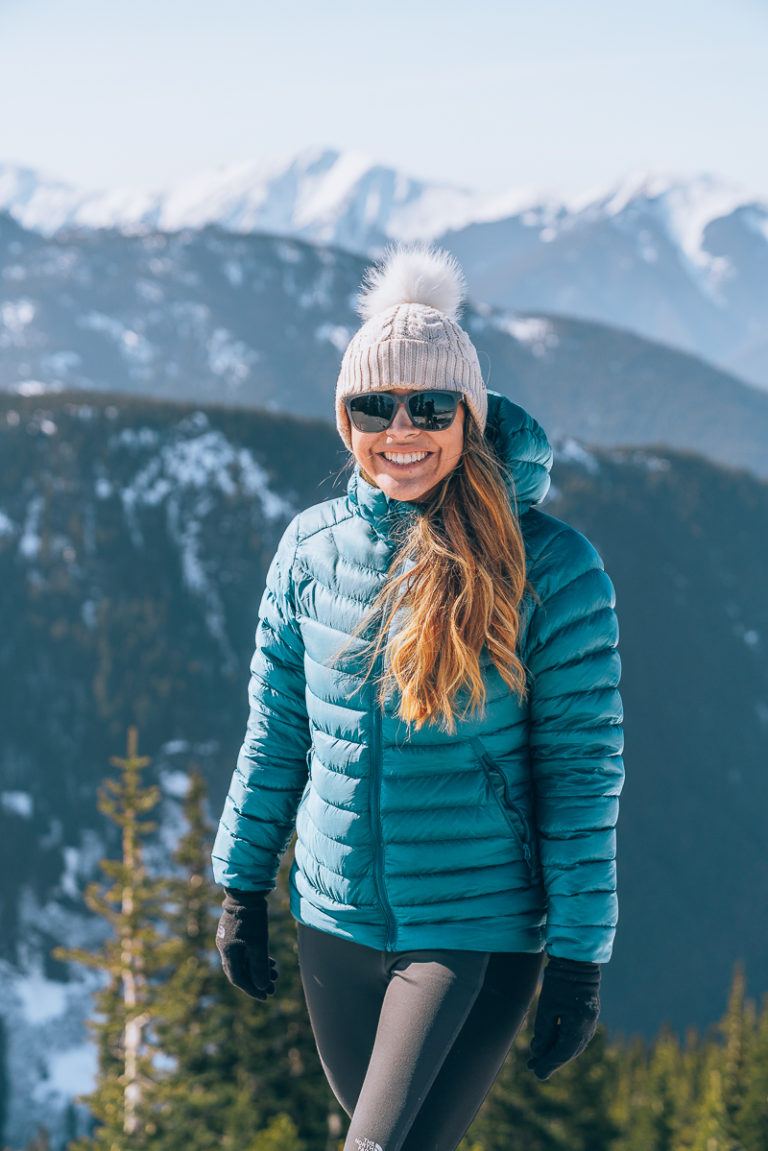
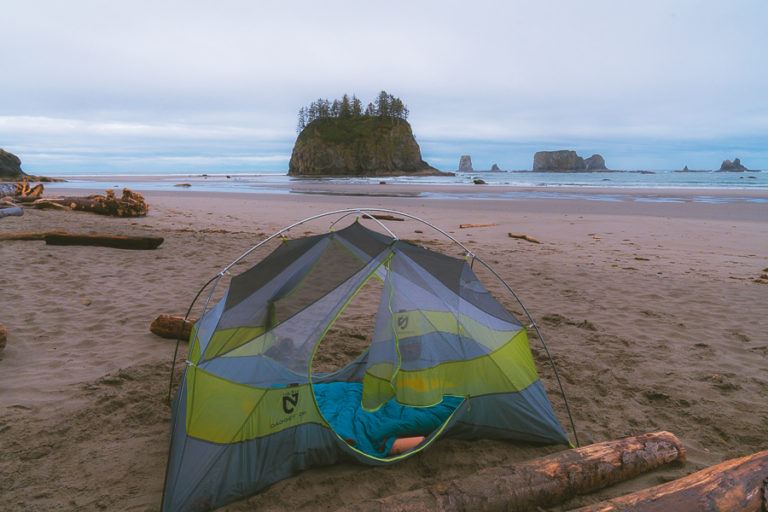
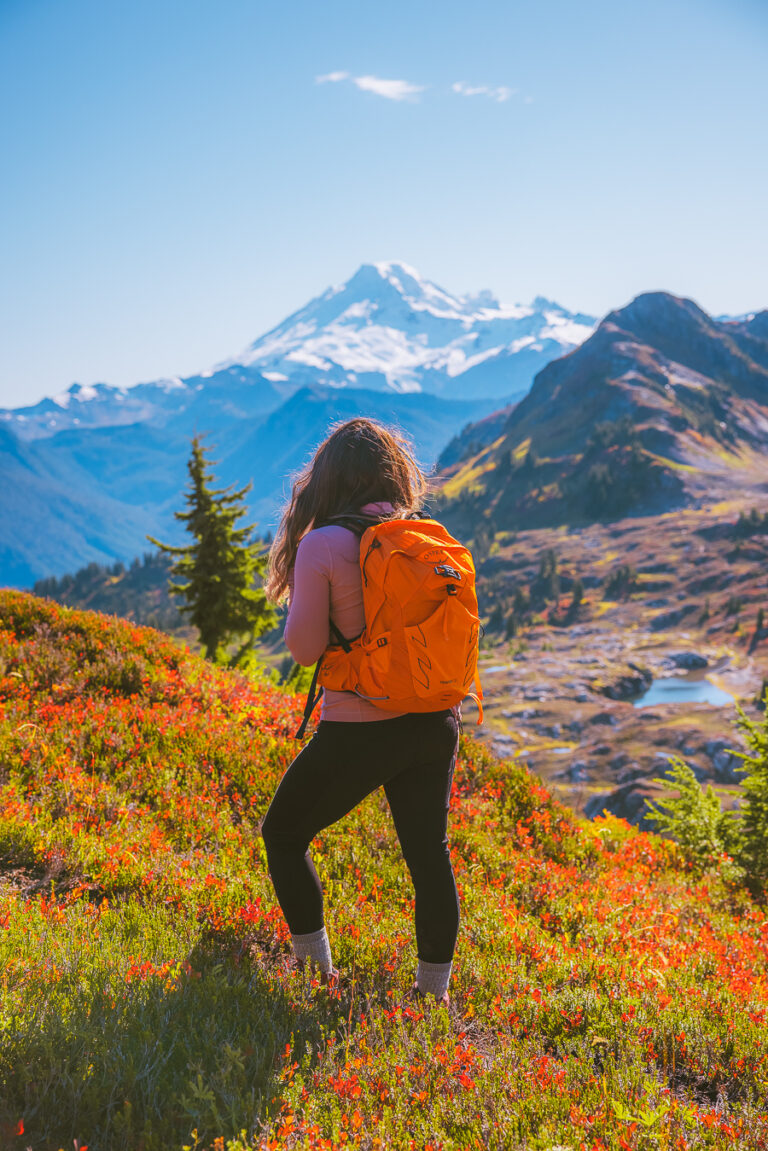
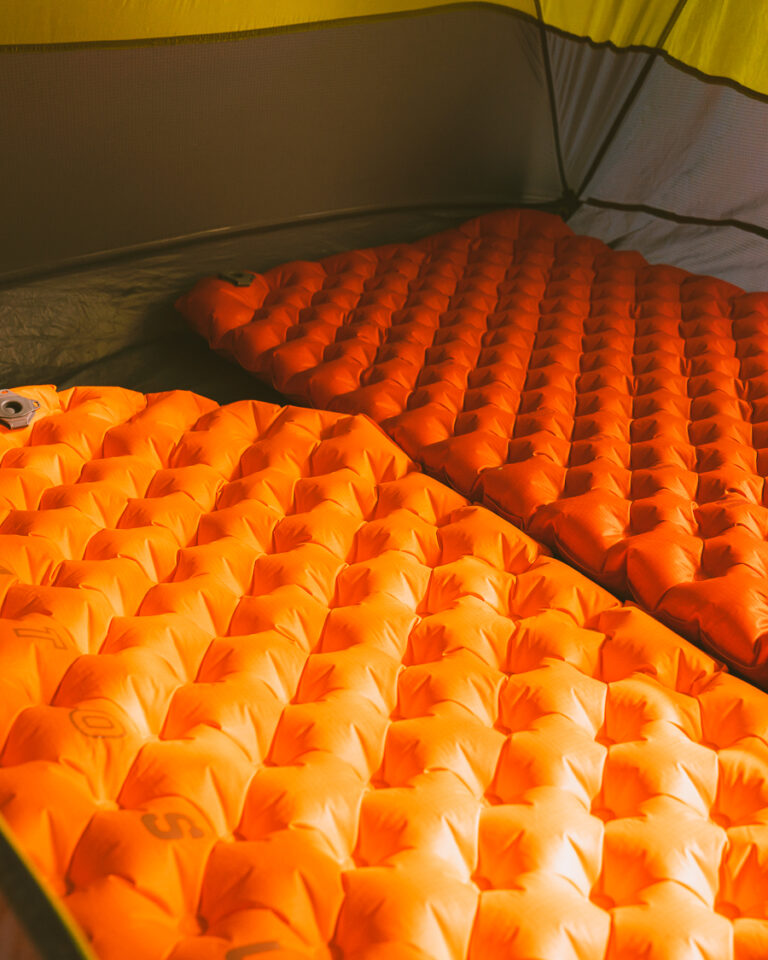
Great post, thanks for sharing. the problem of cold toes is very familiar to me – awesome idea to use hand warmers! why didn’t i think if that? 🙂